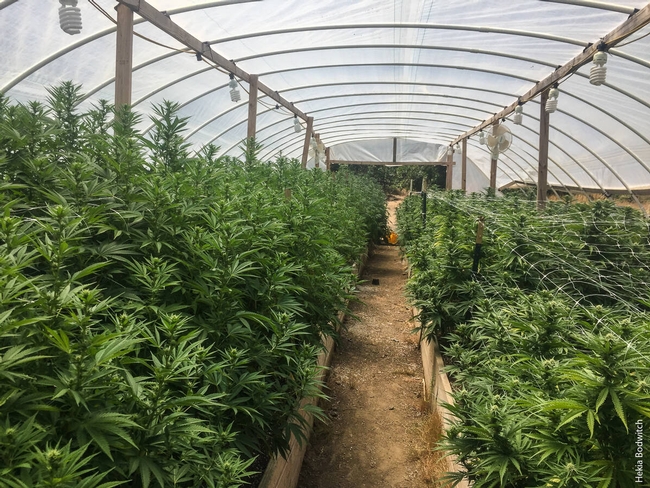A UC Cooperative Extension survey of California registered and unregistered marijuana growers will help researchers, policy makers and the public better understand growing practices since cannabis sales, possession and cultivation first became legal for recreational use.
“This survey is a starting point from which UC scientists could build research and extension programs, if possible in the future,” said lead author Houston Wilson, UC Cooperative Extension specialist with UC Riverside. A report on the survey results was published in the July-December 2019 issue of California Agriculture journal, the research publication of UC Agriculture and Natural Resources.

“I'm there, I'm seeing it. I wanted to know more about this,” Wilson said. “To me, it's a new crop. We've never studied it.”
In 2016, when legalization was in the works, Wilson decided to conduct a survey to better understand the scope of cannabis production in California. A year later, Wilson took a position with the Department of Entomology at UC Riverside as an orchard/vineyard IPM Cooperative Extension Specialist based at the UC Kearney Agricultural Research and Extension Center. He maintained his interest in cannabis and continued to lead the survey project and analyze the data.
The new research report is part of a growing body of knowledge about an industry that represents an estimated $10 billion in retail sales— likely the most valuable of all crop sectors in the state, but largely a mystery to scientists, regulators, growers and civic leaders. Cannabis production has not been widely researched in California because of its legal status before Proposition 64 passed in 2016 and went into effect Jan. 1, 2018.
Under federal law, cannabis remains illegal.
“Since UCCE is federally funded, and cannabis is not legal at the federal level, we cannot conduct any research that has potential to increase yield, improve quality or profitability,” said Robin Sanchez, UC ANR attorney and interim director of administrative policies and business contracts. “We are very careful to conduct research only about its scope and impact, but not production practices.”
Survey respondents
Wilson and his colleagues gathered the information in July 2018 from 101 growers who responded to an online survey. Survey questions focused on farm size, operational features, pest and water management, labor, farm revenue and grower demographics. Respondents were recruited by 15 cannabis grower organizations, who together were able to supply approximately 17,500 contacts.
The respondents were aged from 34 to 72, with 69% male and 29% percent female. Two-thirds were married or living with a partner. More than half had household annual incomes from $50,000 to $99,000; and about 10% from $100,000 to $200,000. Thirty-four percent of growers earned 80 to 100% of their annual gross income from cannabis, while 33% reported no income from cannabis at all.
Most of the respondents produce cannabis in Humboldt, Mendocino and Nevada counties – 55% combined. The rest hailed from 12 other California counties, the furthest south in Los Angeles, and one respondent from Josephine County in Oregon.
Of the growers who responded to the survey, 74% were classified as small-scale growers because their farms were sized at 10,000 square feet or less. The rest were almost evenly divided as medium (10,000 to 20,000 square feet) or large. The majority of respondents (53%) reported that they had not applied for a state license to grow cannabis.
Highlights of findings
- Growing outdoors in open air with sunlight was the most common practice (41%). Twenty-five percent of growers combined outdoor and greenhouse production. Just 10% said they grow the crop entirely within greenhouses.
- Total yield per plant varied by growing location. Outdoor crops yielded on average 2.51 pounds per plant (about 40 ounces per plant), greenhouse crops yielded about 10 ounces per plant, while plants grown indoors with artificial light averaged about 3 ounces per plant.
- The average growing season for outdoor growers was 190 days and they harvested one crop per year.
- In the fall of 2017, the average cannabis sales price was $853 per pound for flowers and $78 per pound for leaves and other non-flower parts.
- The respondents reported using no synthetic pesticides in their cultivation of the crop, suggesting reliance on organic pesticides, biologicals and biocontrol.
- Most growers reported that groundwater was their primary water source for irrigation. Of those, 97% of the water extraction happened from June to October. Many growers said adding water storage was either cost prohibitive or limited by regulatory constraints.
- Growers reported using more than 30 different soil amendments and foliar nutrient sprays. The most common was organic fertilizer, followed by composts and various animal manures and meals, compost tea and worm castings.
- Growers are dealing with 14 different insect pests, 13 diseases and nine vertebrate pests, including gophers, mice, rats, deer and wild boars.
- Powdery mildew was the most commonly reported disease, and mites, thrips and aphids were the most commonly reported insect pests.
- Growers who hired laborers for harvest paid a per-pound piece rate from $50 to $200. The growers who hired seasonal hourly workers offered a starting pay of $15 to $20 per hour.
Project co-authors were UC Berkeley visiting scholar Hekia Bodwitch, Nature Conservancy senior scientist Jennifer Carah, UCCE biocontrol specialist Kent Daane, UCCE natural resources specialist Christy Getz, UCCE climate and water specialist Theodore Grantham and UCCE land use science specialist Van Butsic. Daane, Getz, Grantham and Van Butsic are affiliated with UC Berkeley.
